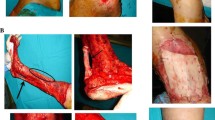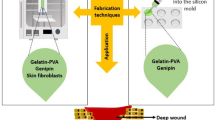Abstract
Dermal substitutes can be used to improve the wound healing of deep burns when placed underneath expanded, thin autologous skin grafts. Such dermal matrix material can be derived from xenogeneic or human tissue. Antigenic structures, such as cells and hairs must be removed to avoid adverse inflammatory response after implantation. In this study, a cost-effective method using low concentrations of NaOH for the de-cellularization of human donor skin preserved in 85% glycerol is described. The donor skin was incubated into NaOH for different time periods; 2, 4, 6 or 8 weeks. These dermal matrix prototypes were analyzed using standard histology techniques. Functional tests were performed in a rat subcutaneous implant model and in a porcine transplantation model; the prototypes were placed in full thickness excision wounds covered with autologous skin grafts.
An incubation period of 6 weeks was most optimal, longer periods caused damage to the collagen fibers. Elastin fibers were well preserved. All prototypes showed intact biocompatibility in the rat model by the presence of ingrowing blood vessels and fibroblasts at 4 weeks after implantation. An inflammatory response was observed in the prototypes that were treated for only 2 or 4 weeks with NaOH. The prototypes treated with 6 or 8 weeks NaOH were capable to reduce wound contraction in the porcine model. In neo-dermis of these wounds, elastin fibers derived from the prototype could be observed at 8 weeks after operation, surrounded by more random orientated collagen fibers. Thus, using this effective low cost method, a dermal matrix can be obtained from human donor skin. Further clinical studies will be performed to test this material for dermal substitution in deep (burn) wounds.





Similar content being viewed by others
References
van Baare J, Buitenwerf J, Hoekstra MJ, Du Pont JS (1944) Virucidal effect of glycerol as used in donor skin preservation. Burns 20(Suppl. 1):S77–S80
van Baare J, Ligtvoet EE, Middelkoop E (1998a) Microbiological evaluation of glycerolised cadaveric donor skin. Transplantation 65:966–970
van Baare J, Cameron PU, Vardaxis N, Pagnon J, Reece J, Middelkoop E, Crowe SW (1998b) Comparison of glycerol preservation with cryopreservation methods on HIV-1 inactivation. J Burn Care Rehabil 19:494–500
Demling RH, Desanti L, Orgill DP (2007) Biosynthetic skin substitutes: purpose, properties and clinical indications, use of skin substitutes, burnsurgery.org, http://www.burnsurgery.org
DeSagun EZ, Botss JL, Srivastava A, Hanumadass M, Walter RJ (2001) Long-term outcome of xenogeneix dermal matrix implantation in immunocompetent rats. J Surg Res 96:96–106
Eppley BL (2001) Experimental assessment of the revascularization of acellular human dermis for soft tissue augmentation. Plast Recon Sur 107:757–762
Hafemann B, Ensslen S, Erdmann C, Niedballa R, Zuhlke A, Ghofrani K, Kirkpatrick CJ (1999) Use of a collagen/elastin-membrane for the tissue engineering of dermis. Burns 25:373–384
Hafemann B, Ghofrani K, Gattner HG, Stieve H, Pallua N (2001) Cross-linking by 1-ethyl-3-(3-dimethylaminopropyl)-carbodiimide (EDC) of a collagen/elastin membrane meant to be used as a dermal substitute: effects on physical, biochemical and biological features in vitro. J Mater Sci Mater Med 12(5):437–446
Jones I, Currie L, Martin P (2002) A guide to biological skin substitutes. Br J Plast Surg 55:185–193
Mackie D (2002) Postal survey on the use of glycerol-preserved allografts in clinical practice. Burns 28:S40–S44
Ravanti L, Kähäri VM (2000) Matrix metalloproteinases in wound repair. Int J Mol Med 6:391–407
Richters CD, Hoekstra MJ, Van Baare J, Du Pont JS, Kamperdijk EWA (1996) Morphology of glycerol-preserved human cadaver skin. Burns 22(2):113–116
Richters CD, Du Pont JS, Mayen I, Kamperdijk EWA, Dutrieux RP, Kreis RW, Hoekstra MJ (2004) Effects of a hydrofiber dressing on inflammatory cells in rat partial thickness wound. Wounds 16:63–70
Richters CD, Hoekstra MJ, Du Pont JS, Kreis RW, Kamperdijk EWA (2005) Immunology of skin transplantation. Clin Dermatol 23:338–342
Srivastava A, DeSagun EZ, Jennings LJ, Sethi S, Phuangsab A, Hanumadass M, Reyes HM, Walter RJ (2001) Use of porcine acellular dermal matrix as a dermal substitute in rats. Ann Surg 233:400–408
Walter RJ, Matsuda T, Reyes HM, Walter JM, Hanumadass M (1998) Characterization of acellular dermal matrices (ADMs) prepared by two different methods. Burns 24:104–113
Zuijlen van PP, Angeles AP, Kreis RW, Bos KE, Middelkoop E (2002) Scar assessment tools: implications for current research. Plast Reconstr Surg 109(3):1108–1122
Weiss SJ (1989) Tissue destruction by neutrophils. N Engl J Med 320:365–376
Author information
Authors and Affiliations
Corresponding author
Rights and permissions
About this article
Cite this article
Richters, C.D., Pirayesh, A., Hoeksema, H. et al. Development of a dermal matrix from glycerol preserved allogeneic skin. Cell Tissue Bank 9, 309–315 (2008). https://doi.org/10.1007/s10561-008-9073-4
Received:
Accepted:
Published:
Issue Date:
DOI: https://doi.org/10.1007/s10561-008-9073-4




